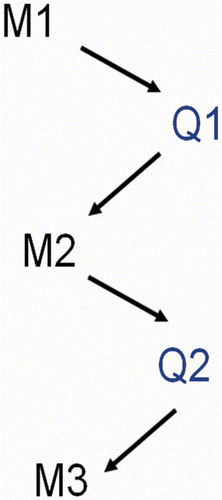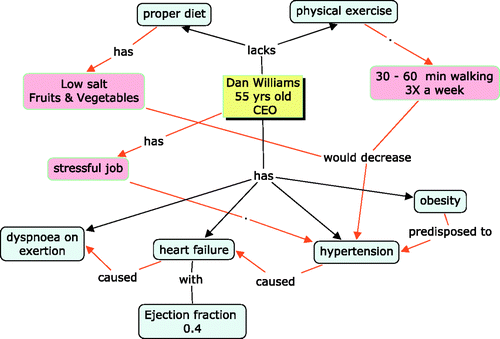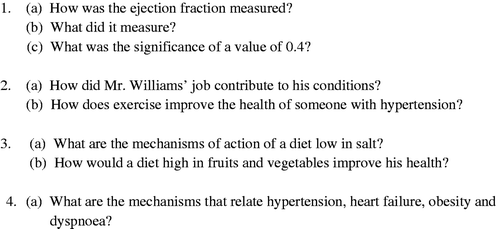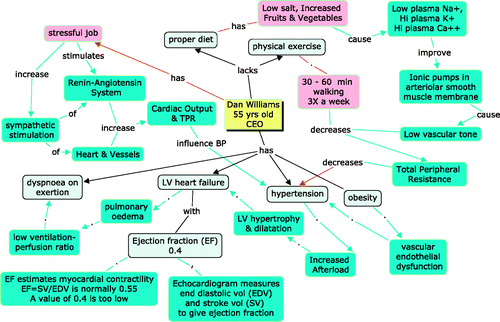Abstract
Background: Problem-based learning (PBL) and concept mapping have been shown to promote active and meaningful learning.
Aim: To design a method of PBL that includes concept mapping and examine students’ perceptions of this form of PBL.
Methods: We designed a 5-phase method of PBL which produced three clearly identifiable mapping phases that reflected the learning activities during the tutorial: (1) the initial understanding of the clinical problem, (2) students’ prior knowledge of the problem, (3) the final understanding of the problem following self-directed study. The process of developing the second and third phases of the map involved the students answering questions that they generated on two occasions to give the entire process a 5-phase approach. Each student was exposed to both methods of PBL: a conventional 7-step method (Maastricht type) and the modified PBL (5-phase) method. We used a questionnaire to evaluate the students’ perceptions of the two methods in four learning domains.
Result: The students’ ratings for the 5-phase method were significantly higher than for the 7-step method (paired t-test) on all items on the questionnaire.
Conclusion: The students perceived the 5-phase method as promoting their passion for learning, and developing their cognitive, metacognitive and interpersonal skills.
Introduction
Problem-based learning (PBL) has been established as an effective system of medical education that is consistent with modern methods of learning (Michael Citation2001; Dolmans et al. Citation2005; Dolmans & Schmidt Citation2006; Michael Citation2006). In PBL, it has been shown that: (1) the presentation of a ‘problem’ to a group of students motivates them to learn new things, (2) activation of prior knowledge at the initial phase of the tutorial promotes processing of new information, (3) encoding new information with retrieval cues enhances information recall and (4) elaboration of information improves later use of that information (Norman & Schmidt Citation1992; Visschers-Pleijers et al. Citation2005; Schmidt et al. Citation2011). Although students learn new concepts around a clinical problem, there is evidence that learned concepts are transferable to new and unfamiliar clinical scenarios (Norman & Schmidt Citation1992).
A number of published reports have advocated the use of mechanistic diagrams to facilitate students learning (Guerrero Citation2001; Azer Citation2005). Mechanistic diagrams do not include the action words between nodes (keywords and phrases) that are essential components of concept mapping; nevertheless, they promote understanding of pathobiological processes and the basis for a patient's clinical presentation. The concept mapping proposed by Novak and Canas (Citation2006) is rooted in Ausubel's Assimilation Theory of Learning (Ausubel Citation2000). The process of constructing a concept map involves identifying key concepts in a text or discussion to serve as nodes and then linking the concepts together using arrows with action words embedded in them for clarity. Such activities involve an analysis and re-synthesis of information, elaboration of knowledge and linking new information to prior knowledge; thus making concept mapping a very useful tool in promoting meaningful learning, critical thinking and problem-solving skills (Irvine Citation1995; Weiss & Levinson Citation2000; West et al. Citation2000; Novak & Canas Citation2006; Rendas et al. Citation2006; Gonzalez et al. Citation2008; Daley & Torre Citation2010). The aims and strategies of concept mapping and those of PBL are such that they naturally complement each other in facilitating learning.
At the Faculty of Medical Sciences, St. Augustine campus, we have been using a hybrid system of lectures and PBL since 1989. The details of our hybrid programme have been described in previous publications (Melville et al. Citation1993; Alleyne et al. Citation2002). The courses in our curriculum are based on organ-systems and integrated across subject disciplines. The students, most of whom are admitted from high school and hence have no prior university education are not expected to diagnose and manage clinical cases at this stage of their training. Hence, the tutorial problems used by our first- and second-year students are designed to emphasize the use of basic science concepts in understanding clinical scenarios. Clinical training for the students takes place in the latter 3 years of our 5 year medical programme.
Our PBL method has been based on the Maastricht 7-step PBL method which has been well described (Schmidt Citation1983). In summary, the 7-step method we have been using comprises the following steps: (1) clarifying unfamiliar terms, phrases and concepts in the clinical problem, (2) identifying issues in the problem that need to be answered or discussed, (3) discussing the issues in a free-flowing discussion (brainstorming) and generating hypotheses to explain the issues, (4) making a systematic inventory of the issues discussed, (5) listing learning objectives that are necessary to address gaps in knowledge, (6) private study of the objectives and related material, (7) reconvening as a group to discuss the objectives and relating the newly acquired information to the clinical problem. The fourth step of our conventional 7-step PBL method (systematic inventory) uses a form of mapping but that PBL method as a whole does not use much mapping.
Although concept maps have been found to be a useful education tool in the health sciences (Weiss & Levinson Citation2000; West et al. Citation2000; Rendas et al. Citation2006; Gonzalez et al. Citation2008), the maps produced tend to be the end products of the group discussions, and lack information about the stages that the group go through during the learning exercise. Hence, our aims were (1) to design a PBL process that combines the conventional 7-step method with concept mapping to produce a 5-phase learning system that has three identifiable mapping phases and two phases of question formulation and (2) to conduct a study on the students’ perception of the 5-phase method in comparison to the conventional 7-step method using a questionnaire.
Methods
Description of the modified PBL method
The concept map that the students used was the spider form that starts with the main clinical problem in the centre of the map rather than at the top as in the hierarchical format of concept maps. We found this approach which is used for mind mapping to be more flexible and better suited to the free flowing discussions at PBL tutorials.
In the 5-phase PBL method the students went through three ‘Mapping Phases’ (M1, M2 and M3) and the two ‘Questioning Phases’ (Q1 and Q2) in the order illustrated in . The first four phases took place at the group session when the students started discussing a new clinical problem, and the last phase (M3) took place after a week of private study.
Figure 1. A diagram showing the sequence of the three mapping and two questioning segments of the 5-phase method.

First mapping phase (M1)
is an example of the clinical problem that a group of students used in a 5-phase PBL tutorial. Students produced a concept map of the clinical problem using the CMAP software that is freely available online (http://cmap.ihmc.us). The map consisted of nouns, keywords or short phrases serving as nodes, and verbs embedded in arrows to show the relationship between nodes (). This first phase map reflected the problem as it was written without any interpretation or extrapolation of the issues identified. One object colour was used for all of M1 to aid in identification of this phase in the final map.
First questioning phase (Q1)
The students identified questions arising from the mapping of the clinical problem (). They also referred to the clinical problem for additional questions, and were encouraged to generate additional questions by considering issues that were outside the written problem, i.e. they were encouraged to think ‘outside the box’.
Second mapping phase (M2)
The students discussed the questions in Q1 and expanded the map to incorporate the new explanations (). This phase of the map reflected the students’ prior knowledge and was distinguished using a second object colour for the nodes and connectors.
Second questioning phase (Q2)
The students identified questions that they were unable to answer during the discussions and which needed to be addressed during their private study. They were encouraged to include as many questions relating to the basic science principles as possible. Some of the questions in the first questioning phase (Q1) were put on the Q2 list because the students were unable to address them during the brainstorming session ().
Third mapping phase (M3)
The students reconvened after a week of private study and discussed the questions in Q2. They expanded the map to reflect their understanding of the issues in the problem. They used a third colour to differentiate this phase of the map from the first two phases (). The resulting map, M3, had three colours to reflect the stages of the students' understanding of the clinical problem and learning activities. Some of the colours of the arrows for the first two maps, M1 and M2 were replaced by intervening nodes in M3 that offered more detailed explanations. During this phase and also the second phase, the discussions that preceded additions to the map included the use of charts, drawings, anatomical structures, etc.
Evaluating students’ perception of conventional versus modified PBL method
The students’ perception of the two PBL methods was tested by choosing four groups of first- and second-year medical students who had been randomly assigned to PBL tutorial groups. There were a total number of 50 students involved in the study with each of the four groups having 11–13 students. Each group of students was engaged in a different course. Each course had six to eight problems; hence, the students used the 7-step method for half the number of problems, and the 5-phase for the other half. Each tutorial session lasted about 3 h, irrespective of whether the students used the 7-step or 5-phase method. When using either the 5-phase or 7-step method, the students met once a week during which time they discussed the learning objectives/questions from the previous problem and then started discussing a new problem for which they generated learning objectives/questions for a week of private study. There were no set time limitations for the steps in the conventional PBL or the 5-phase method; however, the tutor and group leader guided the discussions to ensure that all the steps in either method were adequately covered. Only two PBL tutors were used for the four student groups to minimize the effect of tutor variation on the ratings by the students.
The students in this study were asked to complete a questionnaire anonymously and independently at the end of each course. The study followed the principles in the Declaration of Helsinki and verbal consent was obtained from the students before the study. The questionnaire we used was developed in-house (). The questionnaire had a five-point Likert scale with 5 for strongly agree, 4 – agree, 3 – neutral, 2 – disagree and 1 – strongly disagree. In a pilot study that evaluated the reliability of the questionnaire, the items on the questionnaire had high Cronbach's alphas for four learning domains: affective (e.g. made learning fun and promoted eagerness to learn); cognitive (e.g. critical thinking, learning of factual information and integration of knowledge); metacognitive (e.g. encouraged reflection and provided a solid foundation for future learning) and interpersonal relationships (e.g. positive learning climate and team work). Hence, we considered the questionnaire a reliable instrument to use for this study. Although we were unable to determine the external and measurement validities of the questionnaire, the pilot study did show highly significant correlations amongst the domains, signifying high internal validity of the questionnaire as an instrument.
Table 1. Ratings of the 7-step and 5-phase methods showing the Med, mean and SD for the responses to each question
The ratings of the two PBL methods by the students were analysed using a paired t-test (instead of independent sample analysis) in order to minimize the effects of variations in how individual students rated the questionnaire items. All statistical analyses were performed using SPSS version 16.
Results
presents the median (Med), mean and standard deviation (SD) of the responses from the students. For each questionnaire item, the rating for the 5-phase method was significantly higher than that for the 7-step method (p < 0.01, paired t-test, n = 50).
In this study, the questionnaire was found to be reliable in scoring students’ perception of the PBL methods in the four learning domains. The Cronbach's alphas obtained for the domains were: affective domain, 0.86; cognitive domain, 0.81; metacognitive domain, 0.91 and interpersonal relationships domain, 0.86. Additionally, there were highly significant correlations amongst the four learning domains (Pearson's two-tailed correlations ranged from 0.70 to 0.86; with each of the correlations having p < 0.01). The mean and SD of the scores for the learning domains are presented in . The ratings for the 5-phase were significantly greater than those for the 7-step for each of the learning domains (p < 0.01; paired t-test).
Table 2. The mean and SD of the combined ratings for the listed learning domains
Discussion
This study investigated the students’ perceptions of a conventional 7-step method (Maastricht type) and a 5-phase method that emphasized question formulation and creating three concept maps during the tutorial. We developed an instrument to test the students’ perception of the 5-phase PBL method in comparison to that of the 7-step method. The Cronbach's alphas for the four learning domains were all above 0.70; hence, the questionnaire proved to be a reliable instrument for this study. In this study, as with the pilot one, the questionnaire had high internal validity based on the highly significant correlations amongst the learning domains. The highly significant differences in the paired t-test for each of the learning domains suggested that in our setting, although students perceived that the 7-step method facilitated their learning, they found that the 5-phase method promoted their learning to a much greater extent.
The 5-phase method, being a combination of a conventional 7-step PBL and concept mapping, takes advantage of the benefits associated with both learning strategies. One main additional benefit of the 5-phase method over the conventional 7-step method and other forms of mapping used in medical education was the distinction of the three mapping phases, M1, M2 and M3, which provided a visual representation of the thought processes that went into the students’ interaction with the problem. The first mapping phase, M1, reflected how well the students understood the problem. This process involved analysis and re-synthesis of the clinical presentation to give clear relationships between the clinical features. Such skills are essential for clinical practice in terms of understanding a patient's problem. The second mapping phase, M2, involved activation of prior knowledge and extensive elaboration of information which are key underpinnings of PBL (Norman & Schmidt Citation1992; Schmidt et al. Citation2011). The complexity of M2 is expected to increase as the student's progress in their training. The third mapping phase (M3) reflected how much new information was acquired during private study and applied to the problem. Students were engaged in deep learning (Rendas et al. Citation2006; Visschers-Pleijers et al. Citation2006) by establishing logical relationships amongst the newly acquired facts and concepts and linking them to the knowledge they had before the private study. This phase involved further re-synthesis of information, especially when previously misunderstood concepts needed to be corrected. The three mapping phases ensured that the tutorial process avoided at least two of the challenges of small group learning identified by Dolmans and Schmidt (Citation2006), i.e. haphazard discussion and mini lecturing by students. Additionally, the 5-phase method helped to focus the PBL discussions and reduced the degree of open discussion in the 7-step method which can sometimes be detrimental to small group learning as indicated by Srinivasan et al. (Citation2007). In this study, the advantage of the 5-phase method in facilitating learning was supported by the significantly higher scores of the 5-phase method over the 7-step method on items in the questionnaire that explored the cognitive domain of learning (e.g. critical thinking, learning of factual information and integration of knowledge).
A second benefit of the 5-phase method was the emphasis on students asking questions. There is much more deep learning when students ask questions themselves before answering them, as opposed to being given questions by a professor for them to find answers in many forms of small group learning. The benefit of students asking questions was emphasized by Postman and Weingartner (Citation1971) who indicated that ‘Knowledge is produced in response to questions. And new knowledge results from the asking of new questions; quite often new questions about old questions’. A conventional 7-step PBL method involves asking exploratory questions (Visschers-Pleijers et al. Citation2005). This occurs especially in the ‘problem analysis’ step but not necessarily in the ‘objectives formulation’ step which tends, in many instances, to use action verbs to define the nature of the learning objective. In the 5-phase method, the two questioning phases (Q1 and Q2) are directly deduced from the preceding maps M1 and M2, thus, making it easier for students to formulate relevant and pointed questions for further discussion or private study.
The affective learning domain was addressed by a number of questionnaire items. The paired t-test analysis of items in this domain (e.g. made learning fun, promoted eagerness to learn) showed a significantly higher rating for the 5-phase method than the 7-step. These results show that students greatly enjoyed the 5-phase learning method. Making learning fun and enjoyable is an essential method of driving individual and group learning (Dolmans & Schmidt Citation2006; DiCarlo Citation2009).
Similarly, the significantly higher scores for the 5-phase method on the other two domains: metacognitive (e.g. encouraged reflection, provided a solid foundation for future learning) and interpersonal relations (e.g. provided a positive learning climate, team work) suggest that the 5-phase method promoted the development of other essential learning skills in the students.
Another benefit of the 5-phase method was that it provided an avenue for a content expert to examine the maps and address systematic gaps in the knowledge of the students. Also a map on a particular case can be expanded in future when students encounter new questions or concepts, thus ensuring the continuous use of prior knowledge and promoting spiral learning.
The 5-phase method we have described seems to be most applicable to problem scenarios that are designed to generate explanations that are linked in a variety of ways. It may be that other forms of PBL would be more suitable for other forms of problems or for students at different levels of a medical programme. A limitation of this study was that it did not examine how the two methods impacted on the academic performance of students. An additional limitation was that the study did not assign separate groups of students to either of the two methods thus making it difficult to determine which of the two methods will better prepare students for their clinical years or as practicing physicians. Hence, whilst the results of the study are encouraging, they serve as a basis for future studies to examine how the 5-phase method compares with other small group learning methods, e.g. Team Based Learning or other forms of PBL in the academic performance of students. Similarly, future studies could examine the impact of other forms of concept mapping or mind mapping on learning.
Conclusion
PBL and concept mapping are useful methods to promote active learning and meaningful learning. The 5-phase method combines PBL and concept mapping in a way that they complement each other in achieving the goals of modern methods of learning (Dolmans et al. Citation2005). The responses from students indicated that they perceived the 5-phase method as creating a passion for learning whilst promoting the development of a variety of skills, i.e. cognitive, metacognitive and interpersonal skills.
Acknowledgements
The authors are grateful to Dr George Legall for statistical advice, to the faculty administration for encouraging this study, and the Department of Preclinical Sciences for providing funds for this study.
Declaration of interest: The authors report no conflicts of interest associated with this article. The authors are solely responsible for the content and writing of this article.
References
- Alleyne T, Shirley A, Bennett C, Addae J, Walrond E, West S, Pinto PL. Problem-based compared with traditional methods at the Faculty of Medical Sciences, University of the West Indies: A model study. Med Teach 2002; 24: 273–279
- Ausubel DP. The acquisition and retention of knowledge: A cognitive view. Kluwer Academic Publishers, Boston 2000
- Azer SA. Facilitation of students’ discussion in problem-based learning tutorials to create mechanisms: The use of five key questions. Ann Acad Med Singapore 2005; d34: 492–498
- Daley BJ, Torre DM. Concept maps in medical education: An analytical literature review. Med Educ 2010; 44: 440–448
- DiCarlo SE. Too much content, not enough thinking, and too little fun!. Adv Physiol Educ 2009; 33: 257–264
- Dolmans DH, De Grave W, Wolfhagen IH, van der Vleuten CP. Problem-based learning: Future challenges for educational practice and research. Med Educ 2005; 39: 732–741
- Dolmans DH, Schmidt HG. What do we know about cognitive and motivational effects of small group tutorials in problem-based learning?. Adv Health Sci Educ Theory Pract 2006; 11: 321–336
- Gonzalez HL, Palencia AP, Umana LA, Galindo L, Villafrade ML. Mediated learning experience and concept maps: A pedagogical tool for achieving meaningful learning in medical physiology students. Adv Physiol Educ 2008; 32: 312–316
- Guerrero AP. Mechanistic case diagramming: A tool for problem-based learning. Acad Med 2001; 76: 385–389
- Irvine LM. Can concept mapping be used to promote meaningful learning in nurse education?. J Adv Nurs 1995; 21: 1175–1179
- Melville GN, Wray SR, Addae J, Young LE. Progress in medical education in the Faculty of Medical Sciences, University of the West Indies: Implementation of problem-based learning at the St. Augustine Campus. West Indian Med J 1993; 42: 94–100
- Michael J. The Claude Bernard distinguished lecture. In pursuit of meaningful learning. Adv Physiol Educ 2001; 25: 145–158
- Michael J. Where's the evidence that active learning works?. Adv Physiol Educ 2006; 30: 159–167
- Norman GR, Schmidt HG. The psychological basis of problem-based learning: A review of the evidence. Acad Med 1992; 67: 557–565
- Novak JD, Canas AJ. The theory underlying concept maps and how to construct and use them. IHMC Cmap Tools., Technical Report. Pensacola, FL 2006, [Accessed 16 May 2010] Available from www.ihmc.us
- Postman N, Weingartner C. Teaching as a subversive activity. Delta Books, New York 1971
- Rendas AB, Fonseca M, Pinto PR. Toward meaningful learning in undergraduate medical education using concept maps in a PBL pathophysiology course. Adv Physiol Educ 2006; 30: 23–29
- Schmidt HG. Problem-based learning: Rationale and description. Med Educ 1983; 17: 11–16
- Schmidt HG, Rotgans JI, Yew EH. The process of problem-based learning: What works and why. Med Educ 2011; 45: 792–806
- Srinivasan M, Wilkes M, Stevenson F, Nguyen T, Slavin S. Comparing problem-based learning with case-based learning: Effects of a major curricular shift at two institutions. Acad Med 2007; 82: 74–82
- Visschers-Pleijers AJ, Dolmans DH, de Grave WS, Wolfhagen IH, Jacobs JA, van der Vleuten CP. Student perceptions about the characteristics of an effective discussion during the reporting phase in problem-based learning. Med Educ 2006; 40: 924–931
- Visschers-Pleijers AJ, Dolmans DH, Wolfhagen IH, van der Vleuten CP. Student perspectives on learning-oriented interactions in the tutorial group. Adv Health Sci Educ Theory Pract 2005; 10: 23–35
- Weiss LB, Levinson SP. Tools for integrating women's health into medical education: Clinical cases and concept mapping. Acad Med 2000; 75: 1081–1086
- West DC, Pomeroy JR, Park JK, Gerstenberger EA, Sandoval J. Critical thinking in graduate medical education: A role for concept mapping assessment?. JAMA 2000; 284: 1105–1110





